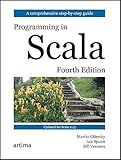Best Scala Programming Books to Buy in January 2026

Functional Programming in Scala, Second Edition



Programming in Scala Fifth Edition



Scala for the Impatient



Functional Programming in Scala



Programming Scala: Scalability = Functional Programming + Objects



Programming in Scala


To write a simple Scala function, you need to follow these steps:
- Start by defining the function using the keyword def, followed by the function name and any parameters it accepts. For example, def greet(name: String): Unit = { } defines a function named greet that accepts a single parameter of type String.
- If your function returns a value, specify its return type after the parameter list using a colon and the type. For example, to return a String, you can write def greet(name: String): String = { }.
- Inside the function body (enclosed in curly braces), write the logic that the function should execute. This can include computations, conditionals, or any other Scala code. For example, println(s"Hello, $name!") will print a greeting with the provided name.
- If your function doesn't return a value, you can use the return type Unit or omit it altogether. In Scala, omitting the return type means the function returns Unit. Unit is similar to void in other languages.
- Once you have defined the function, you can call it using its name and passing any required arguments. For example, greet("Alice") will invoke the greet function with the argument "Alice".
Here's an example of a simple Scala function that takes a name as input and returns a greeting:
def greet(name: String): String = { return s"Hello, $name!" }
val greeting: String = greet("Alice") println(greeting)
In this example, the function greet accepts a name as input and returns a string concatenating "Hello, " and the provided name. The function is called with the argument "Alice", and the resulting greeting is printed to the console.
What is tail recursion in Scala?
Tail recursion in Scala refers to a special type of recursion where the recursive call is the last operation performed in a function. In other words, there are no pending operations after the recursive call.
This type of recursion is advantageous because it can be optimized by the Scala compiler into a loop, which avoids stack overflow errors for large inputs. It is known as tail call optimization (TCO) or tail call elimination (TCE).
To enable tail recursion optimization in Scala, the recursive function must be defined with the @tailrec annotation from the [scala](https://topminisite.com/blog/how-to-use-akka-streams-in-scala).annotation.tailrec package. This annotation ensures that the compiler enforces tail recursion and raises a compile-time error if the function is not tail-recursive.
Here is an example of a tail-recursive factorial function in Scala:
import scala.annotation.tailrec
def factorial(n: Int): Int = { @tailrec def factorialHelper(n: Int, acc: Int): Int = { if (n <= 1) acc else factorialHelper(n - 1, n * acc) }
factorialHelper(n, 1) }
In this example, the factorialHelper function is tail-recursive because the recursive call is the last operation performed in the function. This enables the Scala compiler to optimize the recursion and avoid stack overflow errors.
How to define an anonymous function in Scala?
To define an anonymous function in Scala, you can use the => syntax.
Here's an example:
val add: (Int, Int) => Int = (x, y) => x + y
In this example, add is a variable that is assigned an anonymous function. The function takes two parameters x and y, and returns their sum x + y. The type of the function is explicitly defined as (Int, Int) => Int, indicating that it takes two Int parameters and returns an Int.
You can then use this anonymous function like any other function:
val result = add(5, 3) // result will be 8
What is a recursive function in Scala?
A recursive function in Scala is a function that calls itself within its own body. This allows the function to repeat or iterate a certain logic until a specific condition is met.
By using recursion, a problem can be divided into smaller subproblems that are solved individually. The solution of the subproblems leads to the solution of the original problem.
Here's an example of a recursive function to calculate the factorial of a number in Scala:
def factorial(n: Int): Int = { if (n == 0) 1 else n * factorial(n - 1) }
In this example, the factorial function calls itself with a smaller value of n until n becomes 0, at which point the recursion stops and the result is returned. This function calculates the factorial of a given number by multiplying it with the factorial of the preceding number, down to 1.
Note that when using recursive functions, it is important to define a base case or termination condition that stops the recursion, otherwise the function will continue calling itself indefinitely, leading to a stack overflow error.
How to define a function with no return value in Scala?
In Scala, a function with no return value is defined as a function with the Unit return type. The Unit return type is similar to the void return type in other programming languages.
Here's an example of how to define a function with no return value in Scala:
def sayHello(): Unit = { println("Hello!") }
In this example, the sayHello function does not return a value, hence it is given the return type of Unit. This function simply prints the "Hello!" message to the console. Note that the Unit return type is optional to specify, as Scala will implicitly infer it if not provided.
How to create a higher-order function that returns a function in Scala?
To create a higher-order function that returns a function in Scala, you can follow these steps:
- Define the higher-order function with a return type that represents the function you want to return. For example, you can define a function createAdder that takes an integer as an argument and returns a function that adds a given value to the argument.
def createAdder(x: Int): Int => Int = { // Implementation of the function to be returned }
- Inside the higher-order function, define and return the function that you want to return. In this case, you can return a function that takes an integer y and adds it to the argument x.
def createAdder(x: Int): Int => Int = { (y: Int) => x + y }
- You can then use the higher-order function to create a specific instance of the function:
val adder = createAdder(5) println(adder(3)) // Output: 8
This example shows how to create a higher-order function that returns another function. However, the concept can be expanded to many other use cases and a wide range of return types.
What is an anonymous function called in Scala?
In Scala, an anonymous function is called a "function literal" or a "lambda function".
